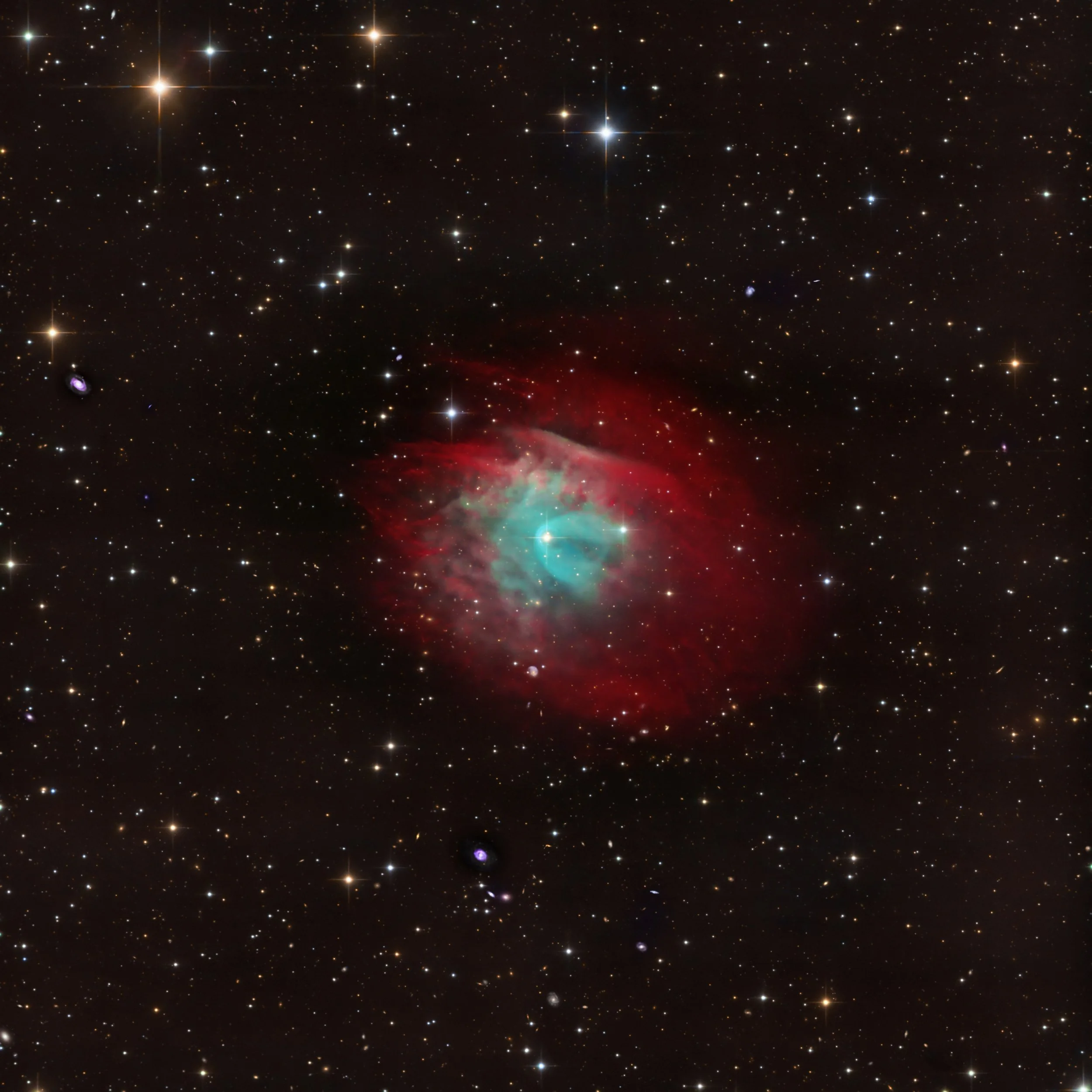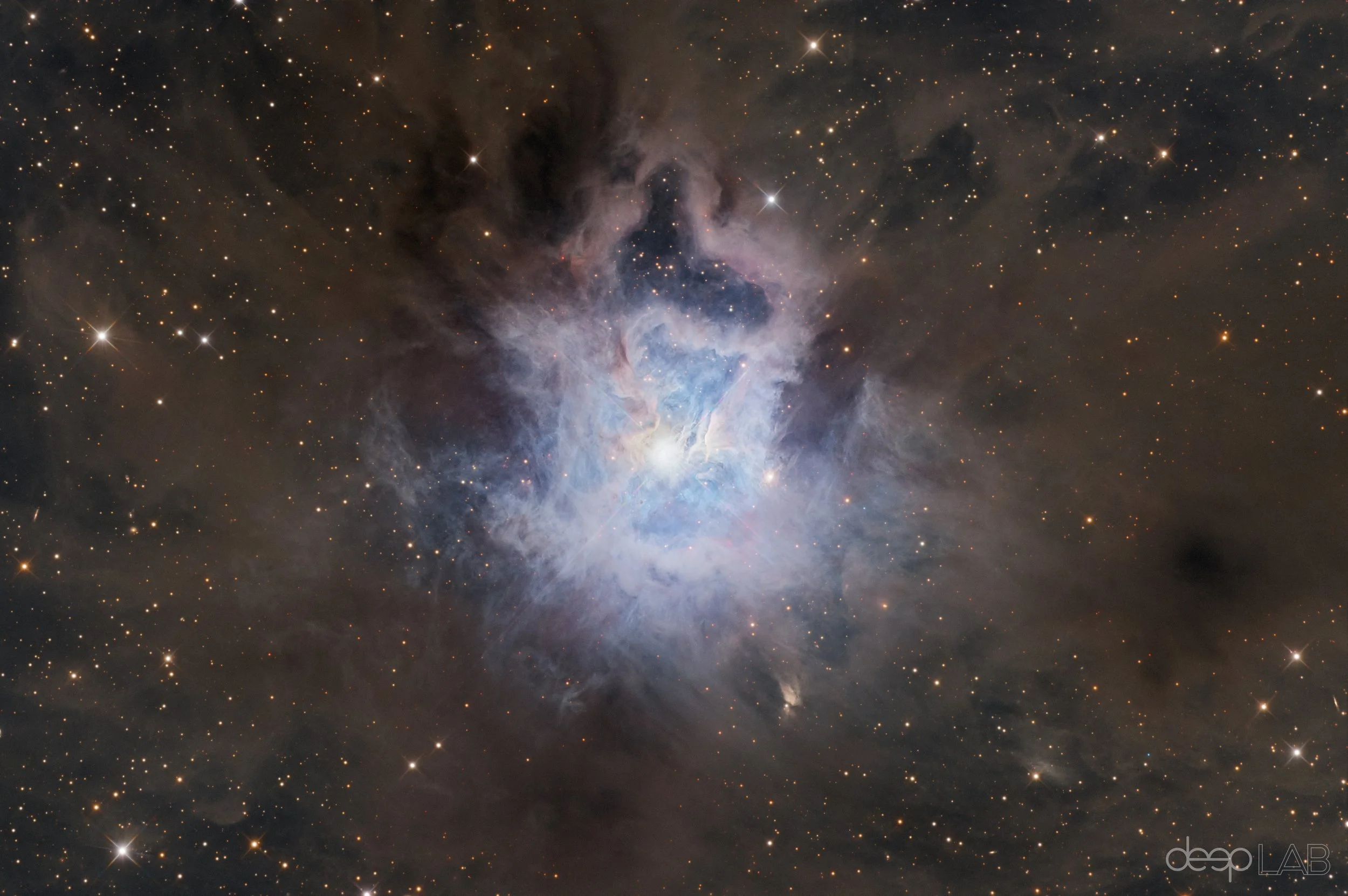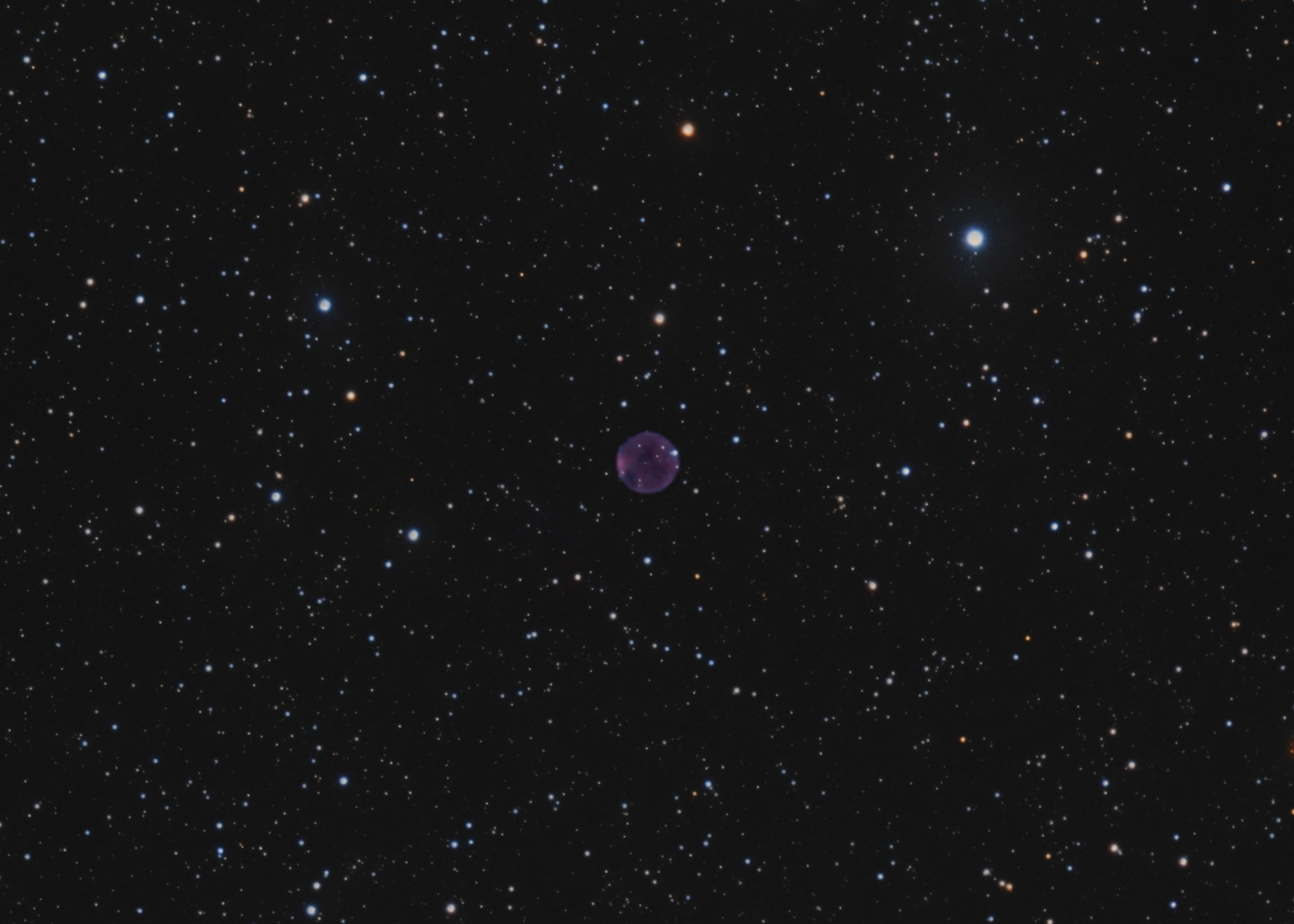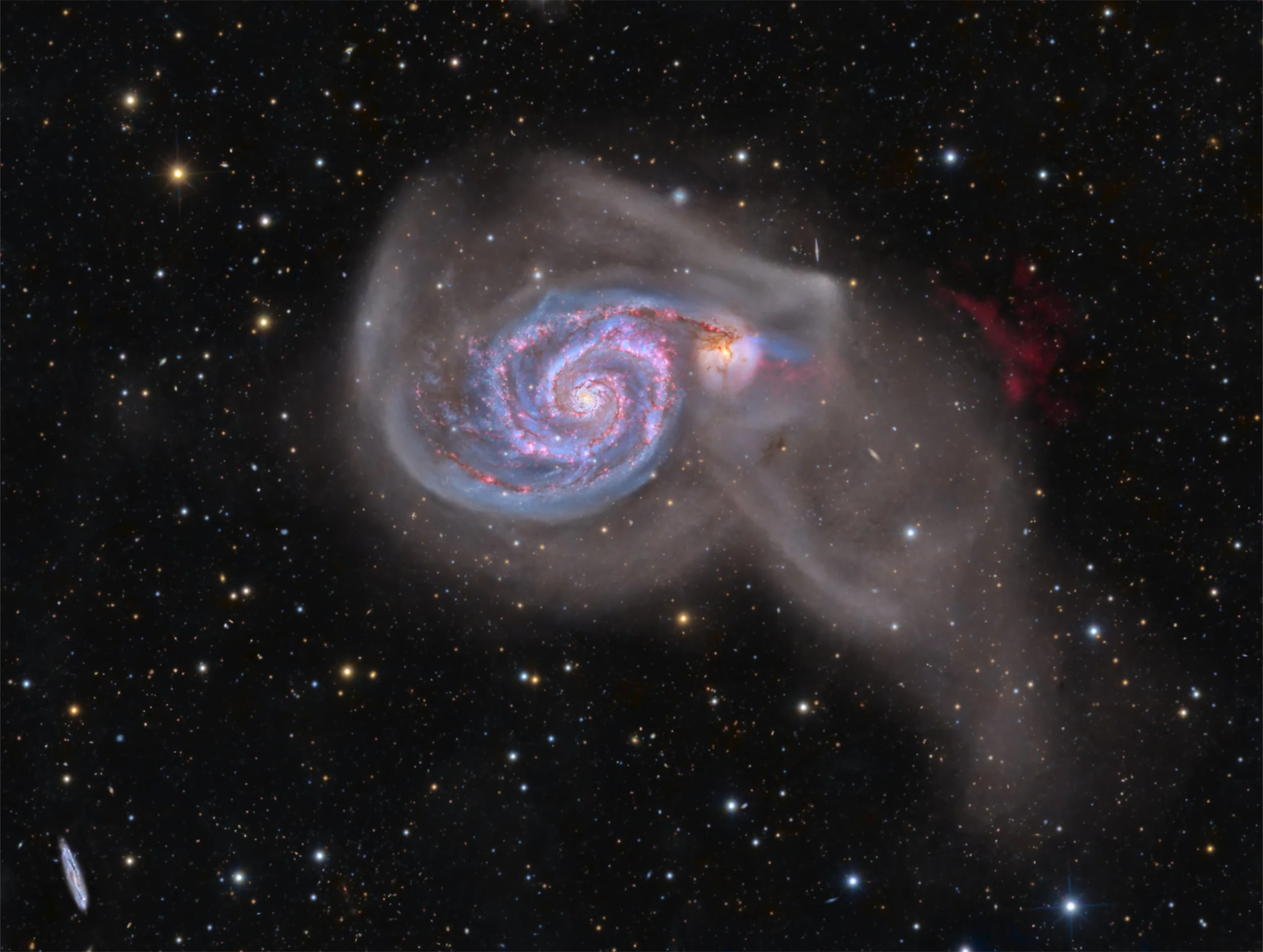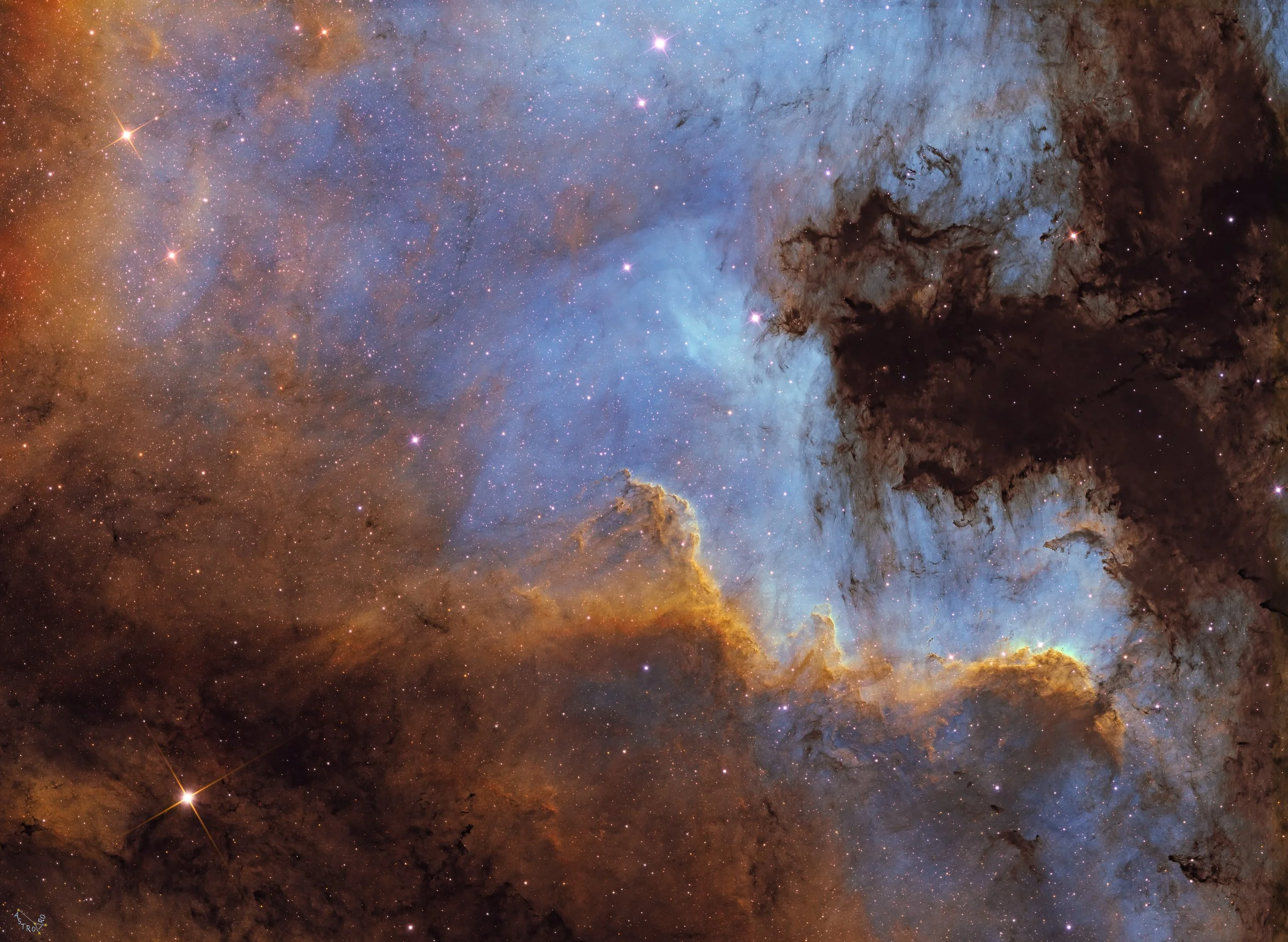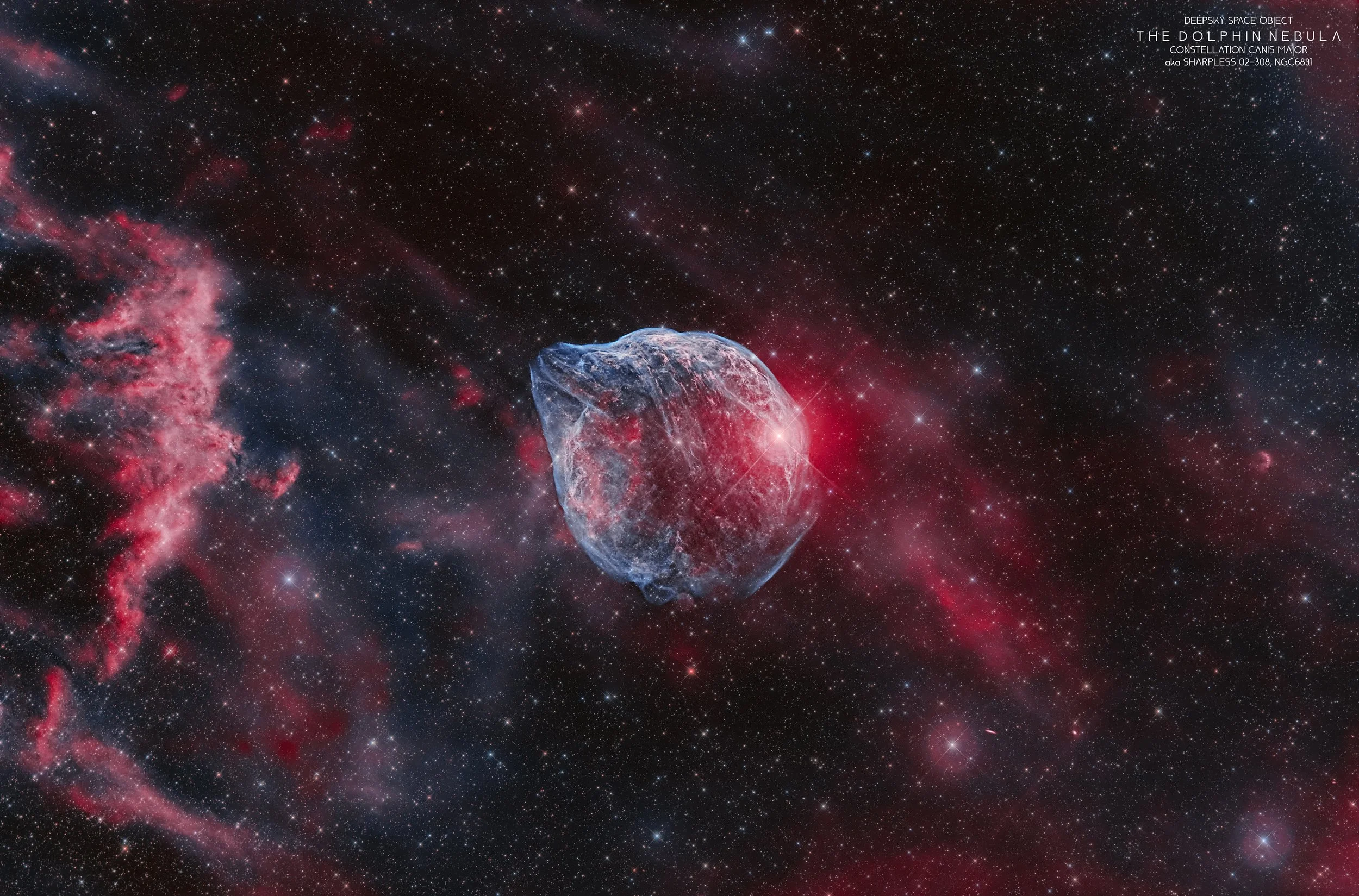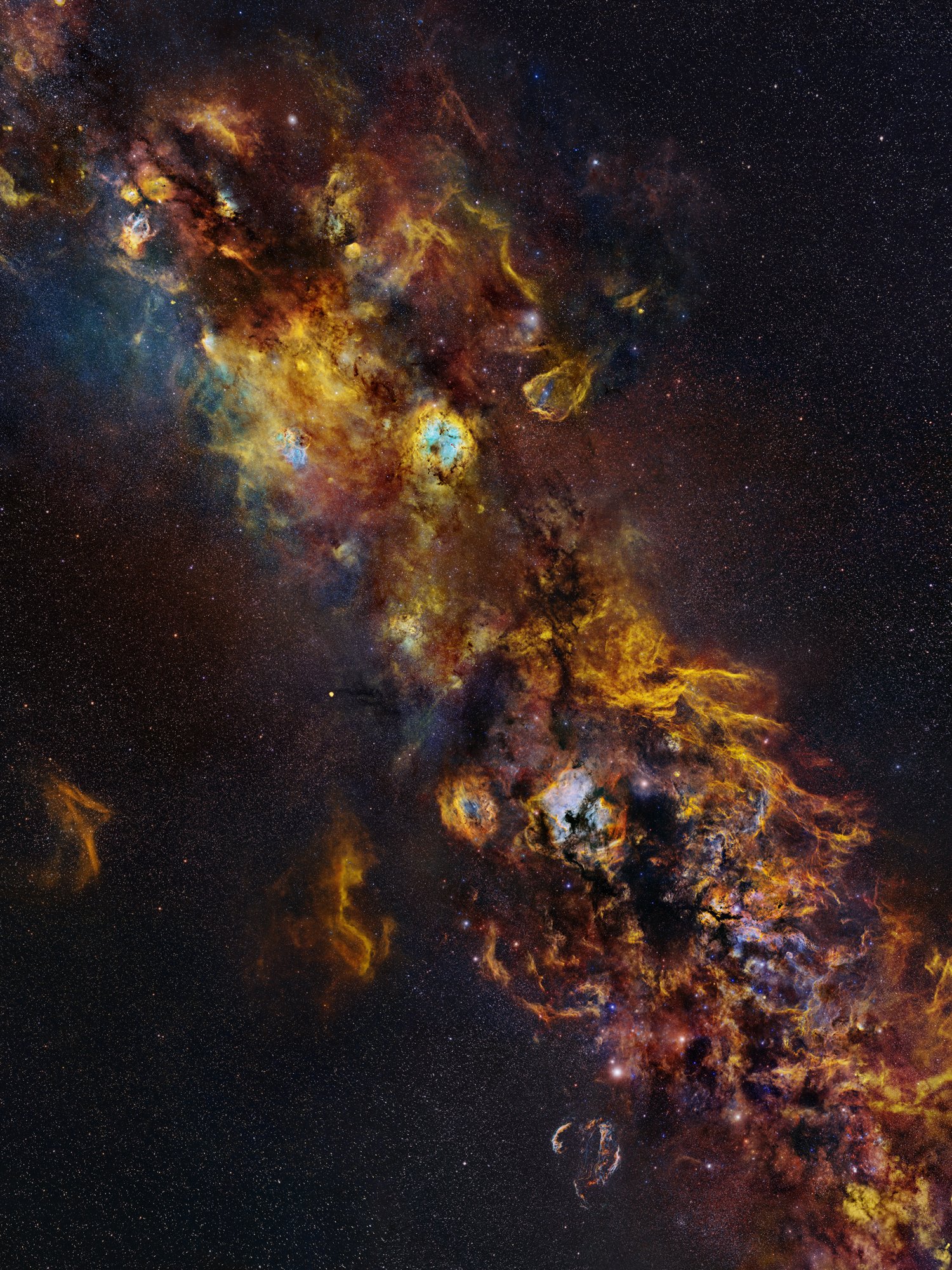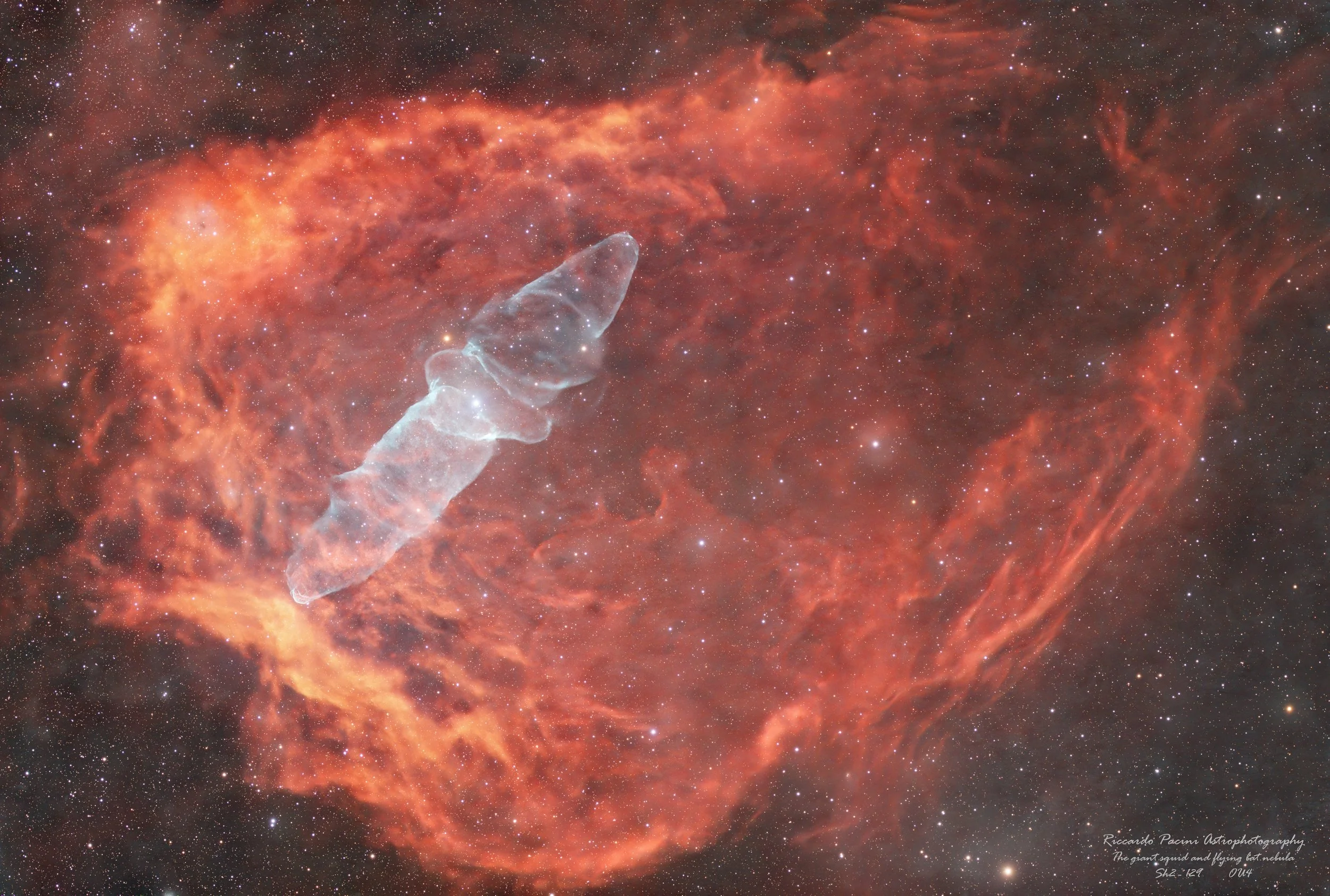
AAPOD2 Image Archives
Abell 35
Abell 35 is a planetary nebula situated in the constellation of Hydra. This intricate shell of ionized gas is the result of a dying star's outer layers being expelled into space, illuminated by the central white dwarf star. Its distinct structure and intricate patterns offer insights into the late stages of stellar evolution. Abell 35's existence aids astronomers in unraveling the complex processes that occur when stars near the end of their lifecycles, enriching the cosmos with elements and showcasing the dynamic nature of the universe.
WR 134
WR 134 resides in the Cygnus constellation as a nitrogen-rich Wolf-Rayet star, belonging to a binary system. These massive stars are characterized by strong stellar winds that strip away their hydrogen envelopes, exposing their dense cores. WR 134's potent winds influence its binary companion and contribute to the galaxy's heavy element enrichment. As short-lived cosmic entities, Wolf-Rayet stars like WR 134 play a pivotal role in the stellar lifecycle, shaping interstellar environments and aiding in the creation of subsequent star generations.
Iris Nebula
The Iris Nebula, also known as NGC 7023, is a stunning emission nebula located in the constellation Cepheus. Its intricate and colorful appearance is caused by the interplay of light reflecting off dust particles and ionized gases within the nebula. Interestingly, the Iris Nebula is illuminated by a variable star named V380 Cephei, which contributes to the dynamic nature of its luminosity.
First image of planetary nebula Si 1-2
Observations of Si 1-2 and other planetary nebulae contribute to our understanding of stellar evolution, as well as the recycling of material within galaxies. The intricate shapes and structures of these nebulae showcase the dynamic interplay between stars and the cosmos, reminding us of the ongoing cycles of creation and destruction that shape the universe.
The Barnard's Galaxy and IFN
Barnard's Galaxy (NGC 6822) takes center stage in this image. Amidst a backdrop of scattered star clusters and other celestial marvels, this capture unveils an elusive wonder known as the Integrated Flux Nebula (IFN). This delicate luminosity originates from the interstellar medium within our own Milky Way galaxy. Capturing the IFN's faint presence stands as a substantial challenge, demanding precise processing techniques, and optimal conditions of a dark night sky. This image provides an opportunity to peer into the intricate interplay between stars, gas, and dust that fills the expanse of interstellar space.
Unveiling hidden features in M51 using 255hours
In a mesmerizing display of cosmic interaction, the Whirlpool Galaxy, also known as M51, unveiled its spiraling arms and intricate features in a stunning astronomical photo that resulted from a 255-Hour Collaboration! This captivating galaxy, located in the constellation Canes Venatici, stood as a prime example of a grand design spiral, with its graceful arms adorned by bright knots of star formation. The exquisite interaction between M51 and its smaller companion galaxy, NGC 5195, was showcased in this image, demonstrating the profound influence of gravitational forces in shaping the evolution of galaxies. The intricate details of M51's structure offered a window into the marvels of galactic dynamics, inviting us to contemplate the vast and ever-evolving tapestry of the universe.
The Cygnus Wall
In a remarkable celestial portrait, the Cygnus Wall unveiled its stunning grandeur within the North America Nebula (NGC 7000). This colossal structure, resembling a jagged and intricate wall of gas and dust, bore witness to the relentless forces of star formation and stellar winds. Energetic young stars nestled within this cosmic tapestry emitted intense radiation, sculpting the wall's mesmerizing contours and cavities. The Cygnus Wall served as an astronomical canvas, illustrating the awe-inspiring interplay between the luminous processes of star-birth and the cosmic architecture that emerges from these dynamic stellar interactions.
THE DOLPHIN NEBULA
In a captivating astronomical revelation, the Dolphin Nebula emerged as a radiant masterpiece against the backdrop of space. Located within the constellation Cassiopeia, this emission nebula's intricate tendrils of glowing hydrogen gas depicted a celestial aquatic scene reminiscent of a leaping dolphin. The intense radiation from nearby stars sculpted these ethereal formations, offering a mesmerizing testament to the profound interplay between stellar processes and the shaping of cosmic landscapes. The Dolphin Nebula stood as a poetic reminder of the artistry innate in the universe, weaving science and imagination into a single, breathtaking vision.
Thackeray's globules in IC 2944
The enigmatic Thackeray's Globules within the IC 2944 star-forming region were unveiled in remarkable detail in this astronomical image. These dense and dark interstellar clouds, shaped by the intricate dance of gravity and radiation, stood as cosmic incubators for new stars. As the vibrant emission nebula IC 2944 illuminated the surrounding space, the intricate contours of Thackeray's Globules came into focus, offering a unique glimpse into the ongoing process of star birth.
ISS Solar Transit
Description: Captured with extraordinary precision and timing, the image showcases the International Space Station (ISS) gracefully gliding across the blazing disk of the sun. Against the backdrop of the sun's fiery corona, the ISS appears as a delicate silhouette, a masterpiece of human engineering juxtaposed against the awe-inspiring forces of the universe.
W63 supernova remnant
In a striking astrophotograph, the W63 supernova remnant was unveiled in all its celestial splendor. This remnant stands as a testament to the cataclysmic end of a massive star. The structures of shockwaves and expanding debris showcased the forces unleashed during the supernova explosion, revealing insights into the dynamic processes shaping the cosmos.
With its intricate filaments and glimmering remnants, the W63 supernova remnant offered a glimpse into the intricate interplay between stellar life and death, underscoring the profound and ever-evolving nature of our universe.
The Unknown Whaler
In a remarkable capture taken near the Lighthouse of Pelican Point, an abandoned shipwreck took center stage against the backdrop of the remote landscape. However, it was the captivating beauty of the Milky Way that truly stole the show. With the celestial band of the Milky Way arching across the night sky, this cosmic display unveiled the intricate structure of our galaxy, a stunning tapestry of stars, dust, and gas. As the Milky Way's faint glow illuminated the shipwreck, the scene became a fusion of science and art, reminding us of our place in the vast cosmos and the profound connections between the universe and the stories of human history
M17 - The Omega nebula
M17, more famously known as the "Omega Nebula" or the "Swan Nebula," is a stunning emission nebula in the constellation Sagittarius, exhibiting intricate, swirling patterns resembling the graceful wings of a celestial swan.
This stellar nursery is a hotbed of ongoing star formation, with its colorful clouds of ionized gas and young, massive stars illuminating the surrounding space and drawing the fascination of both amateur and professional astronomers seeking to unravel the mysteries of stellar birth and evolution.
Cepheus and Cygnus
Cepheus, located in the northern hemisphere, boasts a remarkable emission nebula called the "Wizard Nebula" (NGC 7380), which exhibits a striking resemblance to a wizard casting a spell across the cosmos. Cygnus, also known as the "Swan," features the famous North America Nebula (NGC 7000), a vast cloud of gas and dust in the shape of the continent, captivating observers with its resemblance to the familiar shape of the North American continent.
Flying bat and giant squid
The Squid Nebula, also known as Ou4, is a unique and peculiar planetary nebula located in the constellation Serpens. Unlike typical planetary nebulae with round or elliptical shapes, the Squid Nebula showcases distinctive tentacle-like structures, making it a fascinating object of study for astronomers and a captivating sight for astrophotographers.
VdB 152 Capercaillie Nebula
Behold the mesmerizing beauty of VdB 152, the ethereal Capercaillie Nebula! This celestial masterpiece showcases an intricate dance of vivid colors and wispy tendrils, as newborn stars illuminate the surrounding cosmic canvas with their radiant brilliance, leaving stargazers awe-inspired and humbled by the wonders of the universe.
THE SUN FROM TEXAS
Solar photography is both art and science, capturing stunning images of the Sun, like in this wonderful example, allows photographers and astronomers to document solar phenomena such as sunspots, solar flares, and the ethereal beauty of nearest star.
NGC 7129
IMAGE DESCRIPTION AND DETAILS :
NGC 7129 is a celestial object visible during summer nights in the northern hemisphere (circumpolar visible) in the central-western part of the Cepheus constellation, approximately 4 degrees away from the brightest star of the constellation, Alderamin (magnitude 2.4), in the northeast direction.
NGC 7129 is a reflection nebula located about 3,100 light-years away from Earth. Unlike emission nebulae that emit their own light due to ionization of gas, reflection nebulae do not emit light themselves. Instead, they shine by reflecting the light of nearby stars, typically young and hot stars, that are embedded within or close to the nebula. The light from these stars gets scattered and diffused by dust and gas particles in the nebula, creating a beautiful glow and giving the nebula its characteristic blue color.
NGC 7129 is associated with a young open star cluster, containing young, hot, and massive stars that formed relatively recently from the same molecular cloud of gas and dust.
Reflection nebulae like NGC 7129 typically show characteristic emission spectra with prominent spectral lines of ionized hydrogen (H-alpha) and other elements. The H-alpha line is often observed in red light due to the ionized hydrogen gas.
The dust grains within the reflection nebula can cause interstellar extinction, meaning they absorb and scatter light from background stars, making them appear fainter and redder.
NGC 7129 represents the remnants of a just hatched cocoon of O and B spectral class stars, making it a nursery of sorts. The recently born, young, and powerful stars, estimated to be a few hundred thousand years old, particularly the O-class stars, are among the hottest and most luminous in the universe. Their surface temperatures are significantly higher, exceeding 30,000 degrees Celsius, approximately six times hotter than our star (which shines with yellow light at about 5,600 degrees Celsius). This high temperature makes the O-class stars very bright and contributes to their bluish color.
Currently, their powerful stellar winds are sweeping away the remnants of their cocoons, which, when ionized, give the reflection nebula its visible color spectrum in the image.
Class O stars are stars with a fleeting life, quite different from our own. Due to their mass and high rate of nuclear fuel consumption, they have a short lifespan compared to other classes of stars, quickly (in astronomical terms) depleting their nuclear fuel and ending their existence as brilliant supernovae.
These stars are characterized by the presence of very strong spectral lines of ionized neutral hydrogen (known as H-alpha lines) and other lines of elements such as helium and nitrogen. The presence of these characteristic spectral lines helps astronomers identify and classify O-class stars.
SETUP:
Omegon Pro RC 304/2432 Truss
iOptron CEM120
ZWO ASI2600MM Pro
Acquisition Details:
Optolong Blue 2": 38×300,″(3h 10′)
Optolong Green 2": 38×300,″(3h 10′)
Optolong H-Alpha 3nm 2": 60×600,″(10h)
Optolong Luminance 2": 135×600,″(22h 30′)
Optolong Red 2": 38×300,″(3h 10′) (gain: 100.00)
COPYRIGHT:
DeepLab
ldn673
IMAGE DESCRIPTION AND DETAILS :
Captured at PixelSkies, Castillejar, Spain
Drizzle x2
Lum 100 x 300s
Red 100 x 300s
Green 99x 300s
Blue 97x 300s
33 hours total.
Equipment used:
Telescope: Takahashi Baby Q FSQ-85ED F3.9
Camera: Xpress Trius SX-694 Pro Mono Cooled to -20C
Image Scale: 2.8
Guiding: OAG
Filters: Astronomik Lum,Red,Green,Blue
Mount: iOptron CEM60 "Standard" GOTO Centre Balanced Equatorial Mount
Image Acquisition: Voyager
Observatory control: Lunatico Dragonfly
Stacking and Calibrating: Pixinsight
Processing: Pixinsight 1.8, Photoshop CC, StarXTerminator, StarNet v2, NoiseXTerminator, BlurXTerminator
COPYRIGHT:
David Wills
LDN 1262
IMAGE DESCRIPTION AND DETAILS :
LDN 1262 is a molecular cloud in the constellation Cepheus and about 1000 light years away. It is located near the better known LDN 1251 "Rottenfish Nebula".
Imaging date: 25 and 26 July 2023
Exposure time: LRGB 330′:105:120′:80′ =10h35m
Telescope: 10″f4 ONTC Newtonian
Focal length: 1000mm
Camera/filter: Touptek ATR3CMOS26000KMA with Baader LRGB
Mount: ASA DDM60 Pro
Conditions / SQM: Moon was already slightly interfering and causing gradients especially in the red channel.
Location: Valdín/Spain
COPYRIGHT:
Thomas Bähnck

